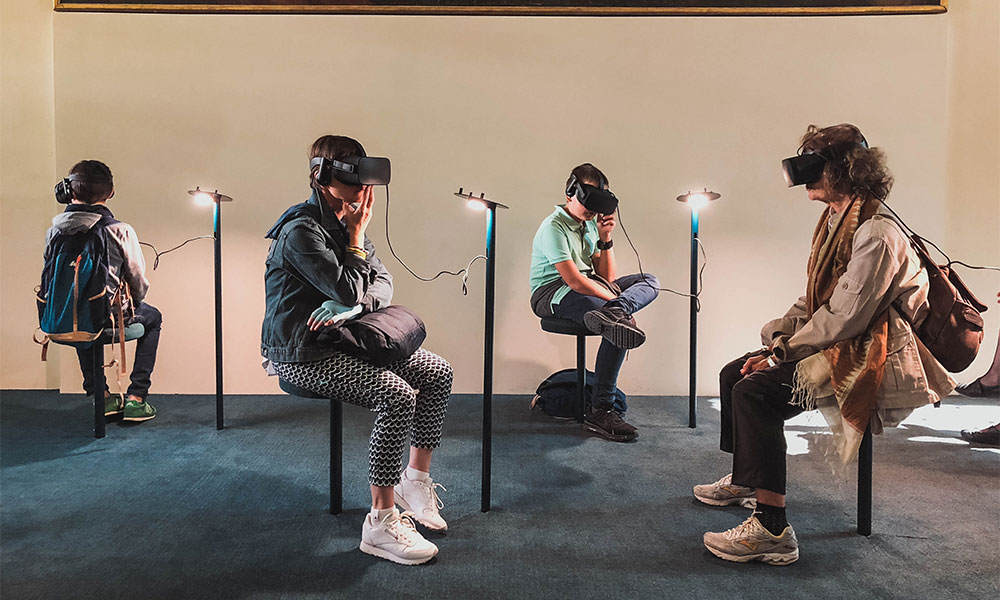It seems like every second of every year a new technology is being rolled out into the world, and as we get our heads around each shiny new product, a new one isn’t far behind. Society is now co-dependent on technology, where we have shops that don’t require human assistance, can talk to our delivery driver from our office via our doorbell, and can even switch on our kettles from the tap of an app a great distance away. Accessibility is also being improved by technology, with the creation of several tools online that support the creation of inclusive digital experiences, through action recognition technologies and site reading tools, for example.
Technology can also help us understand the needs of different people and groups better.
What is Virtual Reality?
Virtual Reality (VR) is the new(ish) kid on the block and, despite being around for a couple of decades, the availability of these technologies has now become more widespread, providing us with new ways to entertain, collaborate, train and educate. VR captures the real world in a computer-generated environment and immerses users in these developed digital environments using head-mounted displays. VR experiences are processed by the brain as real-life experiences, teaching its user to learn by doing as they see the decisions they make, directly affecting the situation around them. With a VR headset on, a chef can become a pilot, an athlete can perform heart surgery, or a child can become a power ranger… the possibilities are endless.
How can we use VR in the workplace?
VR is one of the few ways we can really be empathetic and understand the experiences of someone other than ourselves in a situation we would never experience on an average day. In most work environments, it’s hard to understand what our colleagues deal with because many factors make our experience of the world extremely different to theirs.
Practically, VR can allow for workplace scenarios to be played out and for people to get a real appreciation and understanding of what’s in a role when looking to join, or once in, an organisation. So, for recruitment, retention or for the curious in your workplace, VR could be very useful.
How can EDI leaders apply VR technologies to the work environment?
Creating that understanding of people’s perspectives and experiences is something that diversity and inclusion leaders constantly work to bring attention to - and through the correct strategy, initiatives and goals, aim to create an equal playing field for all. To create this authentic and inclusive environment, it’s important for us to recognise our differences and the value they have. Ethnicity, gender, age, social mobility, sexual orientation and disabilities, make us all unique in our own ways.
Currently, many EDI leaders support their workforces to become more inclusive through training and thought leadership - training focused on topics like unconscious bias, neurodiversity in the workplace and inclusive language modules for staff. Training is delivered in a mix of virtual and in-office settings, with EDI leaders taking the lead and changing the ideologies their workforce holds to improve general organisational culture.
The appetite is there for change and improvement. According to Finance Monthly, 89% of leaders surveyed agreed that the right technology would make achieving EDI goals easier, and virtual reality is one tool, out of many, that can help us further advance these EDI initiatives.
Who are the pioneers in VR EDI training and how do they do it?
VR EDI training is now being piloted by many HR organisations across the world, in businesses like JP Morgan and Amazon, who have used virtual reality technology to change behaviour by learning what it is like to experience discrimination, inappropriate behaviour, working with a disability in the workplace, and how to identify bias. It supports EDI leaders to teach their teams how to deal with challenging situations from the perspective of multiple people. VR technology can have an impact on the general education of a workforce - but can also directly influence the attraction and retention of staff from underrepresented communities, too – something we’re sure to see more of in the world of recruitment over the coming years.
Do you need to create a more engaging Inclusion programme? Speak with our Diversity Consultancy to understand the latest ways to become a more inclusive employer.




